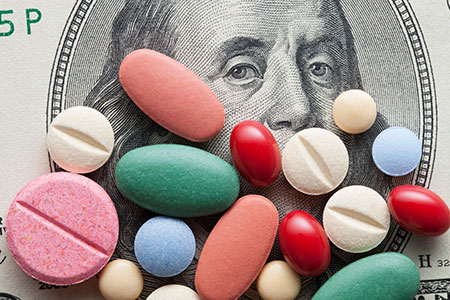DRUG PRICING
US Compared to Other Countries
The cost of prescription drugs in the United States is much higher than in other countries. According to a new report from RAND Corporation, a nonprofit and nonpartisan research organization, prescription drugs cost an average of 2.56 times more in the United States than they do in 32 other countries. For brand name drugs, the variance is even larger, with the US drug pricing averaging 3.44 times more than the other countries in comparison. However, the report also showed that unbranded generic prescription prices in the US are slightly cheaper than in most other countries. For example, unbranded generic drugs account for 84% of drugs sold in the US by volume, yet only account for 12% of US spending. Thus, generic medications are not causing the drug pricing problem in America.
Andrew Mulcahy, lead author of the study and a senior health policy researcher at RAND, said in a statement, “Brand name drugs are the primary driver of the higher prescription drug prices in the United States.” He pointed out that these brand name drugs can cost thousands of dollars per treatment and treat life threatening conditions like Hepatitis C or cancer. According to recent estimates, prescription drug spending accounts for more than 10% of all healthcare spending in the United States. As new, pricey specialty pharmaceuticals are approved, the costs are likely to rise faster than other sectors of healthcare spending over the next decade.
Source: Michael Popke. “Prescription Drug Prices in U.S. More than 2.5 Times Higher than in Other Countries,” Benefits Pro, 2021.Rising Costs of Prescription Wound Care Products
According to a new analysis from OptumRx, pharmaceutical companies are bringing a number of new, high-cost branded wound care treatments to market, which might lead to wasteful spending.
These products have comparable combinations of ingredients to generic and over-the-counter medications, but they are far more expensive. The Sil-K PAD silicone pads, for example, cost $5,499, whereas the over-the-counter alternative only $44. Payers and plan sponsors should be aware of these items, particularly as healthcare expenses grow and affordability becomes more difficult.

Where clinically appropriate, plans can remove these low-value products from the formulary entirely, or utilize other techniques such as prior authorization or step treatment to ensure patients explore lower-cost alternatives wherever possible. Implementing these strategies will become essential to prevent wasteful plan spending as these low-value medications come to market.
Source: Paige Minemyer. “$3.6K Topical Gel? Optum Report Warns of Potential for Wasteful Spending on Pricey,” FierceHealthcare, 2021.GoodRx and PBMs and Payers
GoodRx coupons help patients pay less than the cash price for prescriptions. The coupons are free to use and are accepted at virtually every US pharmacy. GoodRx is beneficial for those members without prescription insurance, however, people with insurance are also allowed to use these coupons. In fact, three out of four members who used GoodRx already had commercial, Medicare or Medicaid insurance. Therefore, insurance premiums are being paid, but bypassing the plan’s out of pocket costs and PBM network rates is more advantageous to the member. As more use the GoodRx coupons and not their insurance, we have to wonder how this is impacting the pharmacy world.
GoodRx had an estimated $3.4 billion in US prescription revenues and earned nearly $500 million in fees from pharmacy benefits managers.
Since the claims are adjudicated by a pharmacy benefit manager (PBM), the medications offered through GoodRx (or any other discount card) are not considered cash-pay. Consequently, benefit designs and network rates can differ among PBMs, creating an opportunity for the patient to reduce out-of-pocket expenses by accessing the rates of another PBM. For example, a member’s copay could be higher than another PBM’s cash price, especially if they are enrolled in a high-deductible health plan. This means a different PBM’s negotiated rate could be lower than the rate available from the PBM of the patient’s primary insurance, which creates a situation where PBM business could be truly disrupted for traditional, non-specialty drugs.
Source: Adam Fein. “How GoodRx’s Rapid Growth Creates Conflict between PBMs and Payers,” Drug Channels, 2021.ONCOLOGY
Background Information About Oncology in the Industry and in the Pipeline
Which class of medication has doubled in spend since 2013 to over $60 billion annually? If you guessed cancer, you would be correct. According to the data firm IQVIA, new oncology medications typically cost $90,000 to $300,000 a year. These prices have risen much faster than patient survival.
What is driving this growth? A few factors. One, we have an eligible patient population that keeps expanding as drugs are approved for conditions that don’t currently have existing treatments. Furthermore, we have an aging population, calls for more innovation and a need for treatments on progressive disease.
Oncology medication will continue to be a major cost driver to many plans in 2021. Four of the top ten anticipated selling drugs for 2021 are cancer treatments. Nearly 40 new cancer drugs were approved in 2019 and 2020. Many are first for their indication with unique and novel mechanisms of action that treat rare cancers with a relatively small patient population. Oncology currently accounts for the largest proportion of clinical development spending in the drug pipeline. It accounts for 37% of the total pipeline expenditure and almost 29% of total pipeline FDA approvals. By 2026, it is estimated that oncology will contribute almost 22% of total pharmaceutical sales.
FDA Accelerated Approval Program
In 1992, Congress gave FDA the ability to accelerate drug approvals based on preliminary study data, responding to protests from HIV patients and activists over the slow pace of drug development. If the drugs weren’t shown to help patients live longer or better lives in follow up studies the approvals would be revoked. The FDA instituted its Accelerated Approval Program to allow for earlier approval of drugs that treat serious conditions, and that fill an unmet medical need based on a surrogate endpoint. A surrogate endpoint is a marker, such as a laboratory measurement, radiographic image, physical sign or other measure that is thought to predict clinical benefit, but is not itself a measure of clinical benefit.
The use of a surrogate endpoint can considerably shorten the time required prior to receiving FDA approval. If approved, the pharmaceutical company is still required to conduct phase 4 confirmatory trials to confirm the anticipated clinical benefit. If the confirmatory trial shows that the drug actually provides a clinical benefit, then the FDA grants traditional approval for the drug. If the confirmatory trial does not show that the drug provides clinical benefit, FDA has regulatory procedures in place that could lead to removing the drug from the market. This, however, has rarely happened, as out of 155 expedited approvals, only 10 have been withdrawn — almost always voluntarily by the manufacturer. The FDA has revoked an expedited approval only once.
Despite this pathway being technically reserved for drugs that fill an “unmet need,” roughly 1/3 of all cancer drugs reach the market through the pathway, including many drugs for overlapping uses. The FDA may be starting to scrutinize this approval process more heavily now.

The FDA met this quarter to consider clawing back approvals from several cancer drugs that have failed to show they extend or improve life. The meeting included discussion on the wave of “immunotherapies” that help the body’s defense system recognize and attack cancer. Follow up studies have come back with either inconclusive or negative data. The agency has only held similar meetings three times in its history, the last one in 2011. This fuels larger debate about balance between speeding drugs to market and confirming clinical benefit. Some of these treatments are showing no benefit over regular chemotherapy in trials and that the drugs had failed to extend survival after initially winning FDA approval based on measures like tumor shrinkage.
The FDA has argued withdrawals as a result of unconfirmed benefit do not necessarily undermine its approach to accelerated approval. They say there is an “Expected trade-off in expediting drug development that benefits patients with severe or life threatening diseases.” The blockbuster drugs have shown life-extending gains against deadly forms of skin and lung cancer, among other conditions. But they’ve also racked up several dozen approvals in other indications, including forms of bladder, throat and liver cancer, that are the focus of the meeting. However, even if all six uses under review are withdrawn, the drugs will stay on the market because they are approved for so many other indications. And that may not change care much for patients.
Sources: "Accelerated Approval",” FDA, 2018. Ben Fidler, Ned Pagliarulo and Johnathan Gardner. “A Look Ahead at the FDA Meeting that Could Decide the Future of 6 Cancer Drug Approvals,” Biopharma Dive, 2021. Matthew Perrone. “FDA to Scrutinize Unproven Cancer Drugs After 10-Year Gap,” AP News, 2021.New Approvals
The FDA approves first immunotherapy for initial (first-line) treatment of gastric cancer. Opdivo (nivolumab) is already on the market but is now approved for advanced or metastatic gastric cancer. There are approximately 28,000 new diagnoses of gastric cancer each year in the US and with the currently available therapy, overall survival is generally poor. The rate of cure with resection is very low and survival rate for all stages is 32% with the five-year survival rate for advanced or metastatic gastric cancer being only 5%
FDA has also approved the first cell-based gene therapy for adult patients with multiple myeloma, named Abecma. This is for patients who have not responded to therapy, or whose disease has returned after at least four prior lines of therapy. What is unique about this therapy is that each therapy is a customized treatment created using a patient’s own T-cells (which are a type of white blood cell). The patient’s T-cells are collected and genetically modified to include a new gene that facilitates targeting and killing myeloma cells. Once these cells are modified, they are infused back into the patient.
Sources: “FDA Approves First Immunotherapy for Initial Treatment of Gastric Cancer,” FDA, 2021. Kranthi Chinthamalla. “FDA Approves First Cell-Based Gene Therapy for Adult Patients with Multiple Myeloma,” APhA News, 2021.BIOSIMILARS
FDA Seeking Consistency
As the biologic drug pipeline increases, the FDA is pushing manufacturers to develop methods to be able to more consistently evaluate their products. Biologic drugs are made from living cells such as a microorganism, plant cell or animal cell, and are therefore often more difficult to analyze and replicate than traditional small molecule drugs. The complex nature of these biologic drugs, including the intrinsic differences occurring in the manufacturing process, can present unique challenges in recreating these products that often do not exist in the development of traditional small molecule drugs.
The challenges experienced with production of these highly-engineered drugs indicate how crucial it is that there are reliable testing processes in place. It can be complicated to scale production of these drugs up from clinical trials for commercial use if there isn’t a reliable way to assess their potency, strength or effectiveness. Many of these biologic drugs entering the market are the first of their kind, so manufactures have yet to identify what characteristics, outcomes or endpoints should be targeted for testing. There have already been some products delayed in development after feedback from the FDA expressing concerns over issues such as these.
Biosimilar Patent Struggles
The Supreme Court recently declined to review a case that would have challenged the patents around Enbrel. This decision means competition will continue to be blocked until at least 2029. Enbrel was originally approved by the FDA back in 1998 and has seen US sales reaching $72 billion since then. There are currently two biosimilars that have been approved, Erelzin in 2016 and Etivcovo in 2019, but neither has made it to market yet due to patents and pending litigation.
Unfortunately, this is a situation that we see repeatedly in the US market, where the uptake of biosimilars has been considerably lower than compared to European markets. Biosimilars are essentially generic versions of biologic drugs like Enbrel. There was hope they would save the US healthcare system billions of dollars through lower-cost competition, but aggressive patent blanketing coupled with the peculiarities of drug pricing and rebating in the US have stalled market utilization. Currently, only about one-third of the biosimilars approved by the FDA since 2015 are available on the market.
Six of the unlaunched biosimilars are copies of Humira, which is AbbVie's top-selling drug and the highest grossing pharmaceutical product on the market in 2020 with sales expected to exceed $20 billion this year. There are settlement deals between AbbVie and biosimilar developers to keep Humira biosimilar products off the market in the US until 2023 even though original patents would have expired in 2017. AbbVie has been accused of specifically targeting the messy US drug market to increase drugs prices over 470% since it was launched in 2003, while cutting costs in other countries. When comparing the US sales with international sales we can see how this accusation was made. Humira had about $16 billion in US sales for 2020 and only $3.7 billion in sales from European sales. Some of this difference in sales can also be attributed to the greater availability of biosimilar products in Europe and their tighter patent laws that include more restrictive definitions of “inventiveness.” AbbVie has defended their “patent thicket” by stating that sales of products today are used to fund the development of future products.

LEGISLATIVE UPDATES
FDA Seeking Consistency
In the midst of the pandemic, we had a change in our country’s leadership with the 2020 presidential election. As the US emerges from the coronavirus pandemic, lowering healthcare costs has been the top priority with bipartisan lawmakers. Trump’s Executive Orders initiated several changes to the healthcare industry, and the Biden administration has continued efforts towards reducing healthcare costs through the Democratic Party’s initiatives.
For starters, the pandemic was a catalyst for changes and expansions of the Affordable Care Act, forcing an improvement in marketplace access and affordability. With increased access for insurance accessibility comes the second issue of drug costs.
State and federal policies are underway addressing concerns from copay accumulators to pharmacy access; several states, including New York, Oklahoma, Arkansas and Georgia, have jumped on the bandwagon.
CVS Health® has identified four key policy issues – proposals that would prohibit the use of preferred networks (anti-steering), restrict mail order (anti-mail), restrict specialty pharmacy services (anti-specialty) and enact pharmacy payment mandates. All of these proposals put self-funded health plans’ ability to maintain an affordable pharmacy benefit at risk. These issues are pending in many states and demonstrate the continued threat the independent pharmacy industry and its allies pose to employer-sponsored coverage.
Below are a few state mandates that have been proposed:
- An NY bill has been proposed to limit mandatory mail-order pharmacy services for specialty drugs advances. Bill sponsor Assemblywoman Latoya Joyner, who serves a district in the Bronx, said the legislation protects consumers’ ability to choose how they want to receive their prescription medications — whether in-store or by mail. “I am very optimistic that the bill will pass the Assembly this year because we have had widespread support from patient groups and independent pharmacies that has grown since I first introduced this legislation,” Joyner said. The bill was first introduced in the 2013 – 2014 legislative session.
- Recently, the Supreme Court of the United States (SCOTUS) ruled that ERISA preemption did not prevent the state of Arkansas from setting minimum pharmacy reimbursement amounts for prescription drugs covered by ERISA self-funded plans. Some state legislatures are making renewed efforts to erode the important protections ERISA provides for employer-sponsored plans.
Some Democrats, including Sen. Bernie Sanders, are pushing to lower the eligibility age for Medicare from 65 to 60, or even lower.
Employer plans spend more money each month, on average, on enrollees ages 60 – 64 than Medicare spends on people 65 – 74, a new KFF analysis found.
Why it matters: Shifting these high-cost enrollees to Medicare would likely save employers a lot of money. But it would also mean payment cuts for hospitals and doctors.
The big picture: Private insurance often pays several times more than Medicare for the same services. The gap in rates is growing.
That means employer coverage keeps getting more expensive — and that money ultimately comes out of the pocket of employers, employees and taxpayers.
People generally use more healthcare services as they age, making the oldest employees the most expensive for employers to cover — and among the most lucrative patients for doctors and hospitals.
By the numbers: Employer health plan spending would plummet if it no longer included older enrollees, a second KFF analysis found.
- If everyone 60 – 64 who is enrolled in large employer plans switched to Medicare, employer plan costs would drop by 15%.
- If everyone 55 – 64 left their employer plans, the costs would decrease by 30%. And if all adults 50 – 64 left, costs would decrease by 43%.

